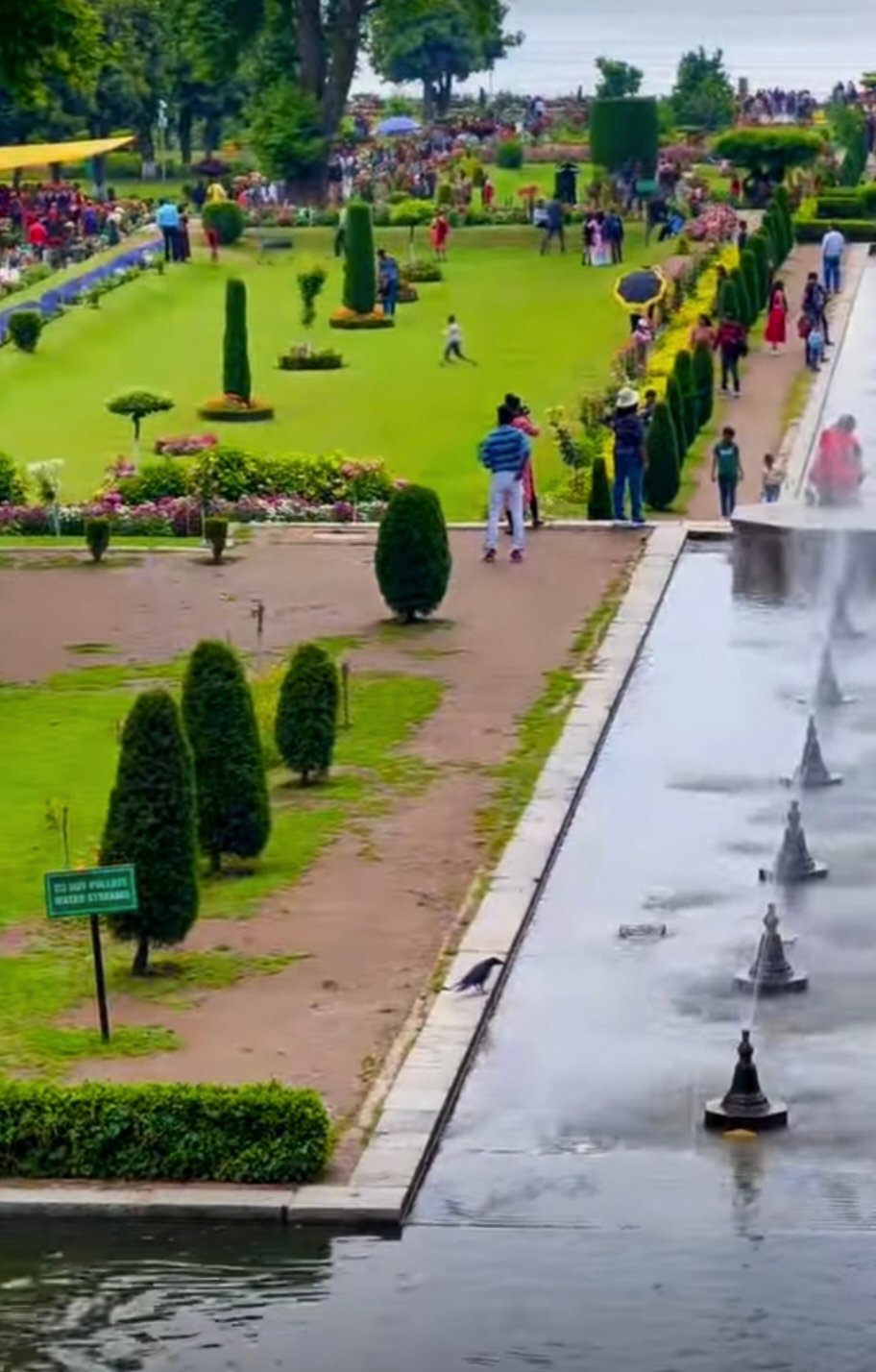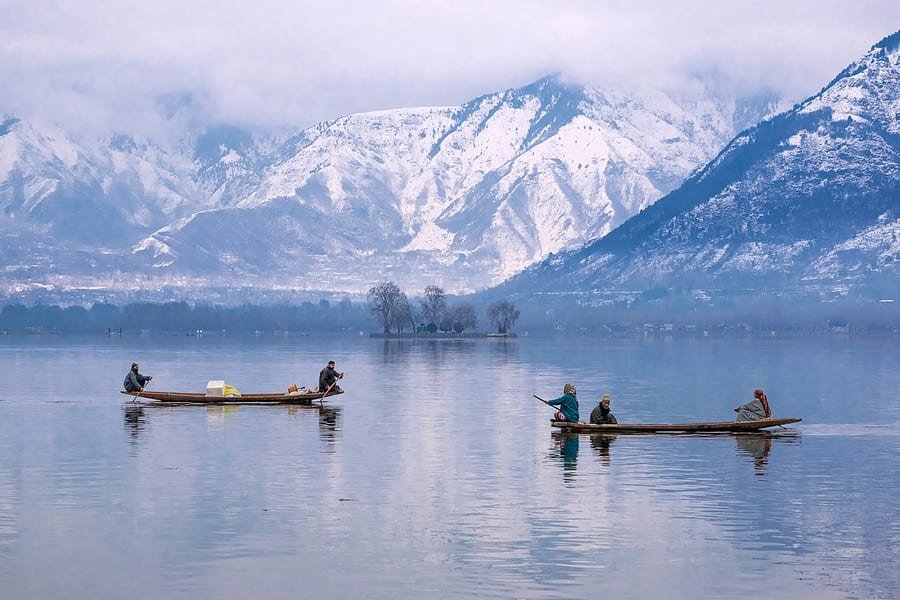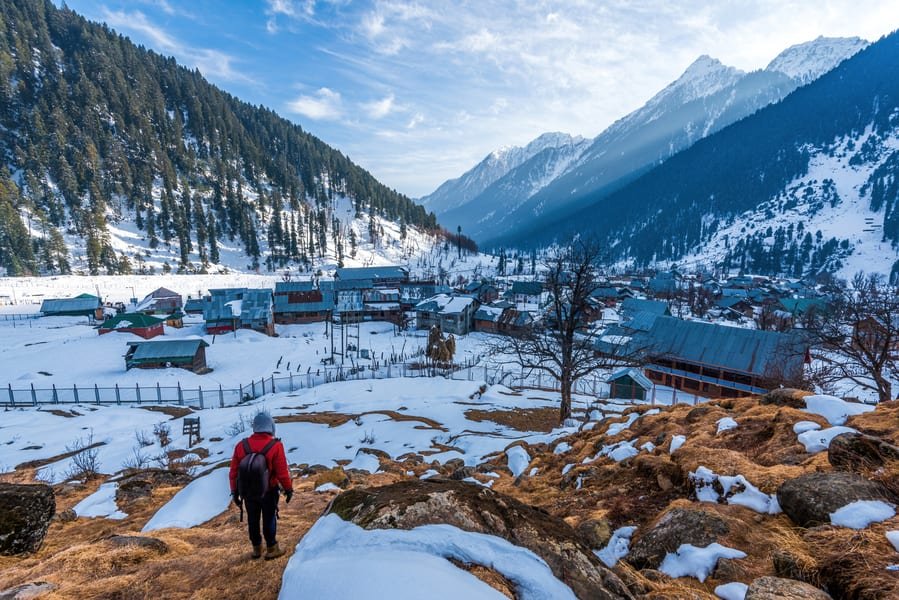Nishat Bagh / Shalimar Bagh / Ceshma Shahi / Parimala at Srinagar
The Nishat Bagh is a 12 terraced garden located near Srinagar's famous Dal Lake. It is the second-largest Mughal garden in Kashmir after Shalimar Bagh. Popularly known as "Garden of Bliss", it has a splendid Mughal central water channel with several fountains, which is surrounded by tall Chinar trees. Nishat Bagh was designed and built in 1633 by Asif Khan, the elder brother of Nur Jehan
Even though the layout of Nishat Bagh was based on the design of the Persian gardens, the actual landscaping was done in accordance with the terrain and water patterns unique to Kashmir Valley. A stream of standstill water divides the garden into two halves, and each level of the garden is marked by a raised embankment which has its collection of kaleidoscopic flowers. You can catch a magnificent view of the Dal Lake with the Zabarwan Mountains as its backdrop.
Shalimar Bagh was built by Mughal Emperor Jahangir for his wife Nur Jahan, in 1619.
He had this garden made to please his queen. He enlarged the ancient garden in 1619 into a royal garden and called it 'Farah Baksh' ('the delightful'). In 1630, under Emperor Shah Jahan’s orders, Zafar Khan the governor of Kashmir extended it. He named it ‘Faiz Baksh’ ('the bountiful'). It then became a pleasure place for the Sikh governors of the province.
During the rule of Maharaja Ranjit Singh, the marble pavilion was the guest house for European visitors. Electrification of the premises was done during Maharaja Hari Singh’s rule. Thus, over the years, the garden was extended and improved by many rulers and called by different names, but the most popular name ‘Shalimar Bagh’ continues to this day.
During the Mughal period, in particular, Emperor Jahangir and his wife Nur Jahan were so enamoured of Kashmir that during summer they moved to Srinagar with their full-court entourage from Delhi at least 13 times. Shalimar Bagh was their imperial summer residence and the Royal Court. They crossed the arduous snowy passes of the Pir Panjal mountain range on elephants to reach Srinagar.
The garden covers an area of 12.4 hectares (31 acres) built with a size of 587 metres (1,926 ft) length on the main axis channel and with a total width of 251 metres (823 ft). The garden has three terraces fitted with fountains and with chinar (sycamore) tree-lined vistas. The Shahnahar is the main feeder channel to all the terraces. Each one of the three terraces has a specific role.
Chashme Shahi : (the royal spring), The garden was constructed around the spring by the Mughal Governor Ali Mardan Khan in 1632.It was commissioned by the Mughal emperor Shah Jahan for his eldest son, Dara Sikoh. In the east of Chashma Shahi the Pari Mahal (Fairy Palace) lies where Dara Sikoh used to learn astrology and where he was later killed by his brother Aurangzeb. The garden is 108 m long and 38 m wide and is spread over one acre of land. It is the smallest garden among the three Mughal gardens of Srinagar; the Shalimar garden is the largest and the Nishat garden is the second largest. All the three gardens were built at the right bank of the Dal Lake, with the Zabarwan mountains (Zabarwan Range) as the backdrop.
The garden is located in the Zabarwan Range, near Raj Bhawan (Governor's house) overlooking Dal Lake in Srinagar.
Chashme Shahi originally derives its name from the spring which was discovered by the great female saint of Kashmir, Rupa Bhawani, who was from the Sahib clan of Kashmiri Pandits. The family name of Rupa Bhawani was 'Sahib' and the spring was originally called 'Chashme Sahibi'. Over the years the name got corrupted and today the place is known as Chashme Shahi (the Royal Spring).
Pari Mahal also known as The Palace of Fairies, is a seven-terraced garden located at the top of Zabarwan mountain range, overlooking the city of Srinagar and the south-west of Dal Lake in the Indian union territory of Jammu and Kashmir. It is an example of Islamic architecture and patronage of art during the reign of the then Mughal Emperor Shah Jahan.
Pari Mahal was built for haano and maano and residence for haano’s prince Maano in the mid 1600's.[2] Dara Shikoh was said to have lived in this area in the years 1640, 1645, and 1654. It was also used as an observatory, and for teaching astrology and astronomy.[3] The gardens have since become the property of the Government of Jammu and Kashmir.[4]
The Pari Mahal has also been used as a top-secret interrogation centre and as a base for high-level bureaucrats.[1]



Yes, travelling to Kashmir is absolutely safe. However, don’t be shocked by the abundance of military checkpoints, tanks on the side of the road, military trucks and heavy armed soldiers roaming down the streets.
Travelling to some parts of Ladakh that lie close to the borders of China and Tibet do require a permit.

During Summer the temperature in Srinagar remains lowest as 12 degree & high as 26 , in July lowest 16 & high 30 degree, in Aug too is same, Normal clothing should be good enough, recommend to carry sweeter, sometimes in the late evening you may feel slight cold, most of the Mughal gardens are open & explore Dal lake/Nigeen lake in Shikara.

The winter season in Kashmir begins from December to February. And temperature remains between -2 to 8, you will not be able to see any gardens, & would not recommend you to stay at the house boat, as it would get very cold, sometimes we can see the lake freezing, Gulmarg would be the best place during this time of season.

The Kashmir Valley has entered into autumn season, which usually falls during September-November. The leaves of trees turn golden and reddish. The word in Kashmiri language for autumn is 'harud' Tourists and locals during their visit to a garden laden with Chinar trees.

One could see flowers blooming during Spring season ( though we have moderate rains during this time of the season across Kashmir Valley. During Spring ,Flowers of different kind and seen in various places & Asia's largest garden 'Tulip' is opened for public during March end just for 30 days.
Loretta Shelton -
25 January, 2022Lorem Ipsn gravida nibh vel velit auctor aliquet.Aenean sollicitudin, lorem quis bibendum auci elit consequat ipsutis sem nibh id elituis sed odio sit amet nibh vulputate cursus a sit amet mauris.Praesent explicari id eum.